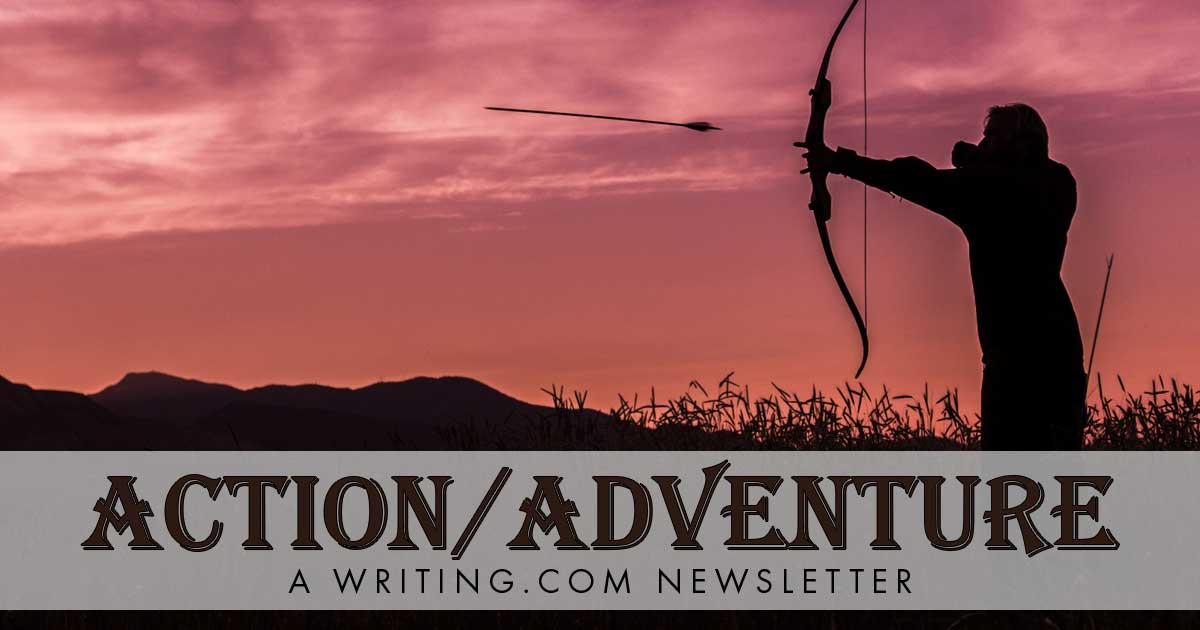This week: Elements of Adventure Writing Edited by: Annette-Outta Town-See Ya 8/22  
More Newsletters By This Editor 
![Table of Contents [#401437]
Table of Contents](https://shop.Writing.Com/main/trans.gif) ![Table of Contents [#401437]
Table of Contents Table of Contents](/main/images/action/display/ver/1709303267/item_id/401437.png)
1. About this Newsletter
2. A Word from our Sponsor
3. Letter from the Editor
4. Editor's Picks
5. A Word from Writing.Com
6. Ask & Answer
7. Removal instructions
![About This Newsletter [#401439]
About This Newsletter](https://shop.Writing.Com/main/trans.gif) ![About This Newsletter [#401439]
About This Newsletter About This Newsletter](https://www.writing.com/main/images/action/display/ver/1709303676/item_id/401439.png)
| Rope your reader into your adventurous plot with maximum suspense by including the tried and true elements of most action stories since Homer's Odyssey. |
![Letter from the editor [#401442]
Letter from the editor](https://shop.Writing.Com/main/trans.gif) ![Letter from the editor [#401442]
Letter from the editor Letter from the editor](https://www.writing.com/main/images/action/display/ver/1709303784/item_id/401442.png)
Elements of Adventure Writing
Here we go again with the hero's journey as identified by author and literary professor Joseph Campbell. Why does it keep showing up?
It keeps showing up not because it is a blueprint on how to write, but on how those stories were written.
Why do we keep using it like a blueprint? Because it works. From Gilgamesh to Luke Skywalker, storytellers of all ages (not the writer's age - the age of the time the story was written in) have followed the hero's journey whether they called it that or not.
To keep your reader glued to the page (screen), you must include these components:
The Hero
Just to get this out of the way: a hero is not always male. A hero can be female, male, undecided, fluid, or an animal. If you want to go wild, you can use plants or inanimate objects too. The whole point of the hero is to give the reader someone to latch on to. Someone to root for. Someone to follow around on the adventure.
The Quest
A problem needs solving. Something needs to be found. Something needs to be transported. Take your pick of these or write any other type of plot sequence that gives a reason for the story to exists in the first place. How many times have you read a story or watched a movie and wondered, "Why didn't they just to X?" Because if they had done X, there would be no story. So don't try and reinvent the wheel. Just make sure you story has something that needs to get accomplished.
The Environment
Ideally, you will give your hero a journey that goes from familiar to unfamiliar. There are many options here. Two typical storylines are a stranger comes to an unknown town, or the hero leaves to unknown pastures. Either way, being in a place that the hero can't control adds risk for the character and can be used to increase the story's tension.
The Villain
As the protagonist goes about the quest, there has to be an antagonist. This can be a person, nature, something else. The villain's job is to make the quest harder.
The Risk
No risk = no reward. If your main character never faces any perilous situations, you do not have an action/adventure on your hands. The quest has to make the hero face danger and force decisions that could put lives or at least health and limb at risk.
The Transformation
Going through the quest has to leave a mark on the hero. Not necessarily a scar, but it has to affect your main character's outlook on life, skill sets, and further plans. If there is absolutely no metamorphosis, why did the story even exist? The hero's adaptation to life after the quest, or a life of questing is the whole point of action/adventure stories.
|
![Editor's Picks [#401445]
Editor's Picks](https://shop.Writing.Com/main/trans.gif) ![Editor's Picks [#401445]
Editor's Picks Editor's Picks](https://www.writing.com/main/images/action/display/ver/1709303830/item_id/401445.png)
| |  | Invalid Item 
This item number is not valid.
#2256006 by Not Available. |
|
![Word From Writing.Com [#401447]
Word from Writing.Com](https://shop.Writing.Com/main/trans.gif) ![Word From Writing.Com [#401447]
Word from Writing.Com Word from Writing.Com](https://www.writing.com/main/images/action/display/ver/1709303874/item_id/401447.png)
Have an opinion on what you've read here today? Then send the Editor feedback! Find an item that you think would be perfect for showcasing here? Submit it for consideration in the newsletter!
https://www.Writing.Com/go/nl_form
![Ask & Answer [#401448]
Ask & Answer](https://shop.Writing.Com/main/trans.gif) ![Ask & Answer [#401448]
Ask & Answer Ask & Answer](https://www.writing.com/main/images/action/display/ver/1709303902/item_id/401448.png)
![Unsubscribe [#401452]
Removal Instructions](https://shop.Writing.Com/main/trans.gif) ![Unsubscribe [#401452]
Removal Instructions Removal Instructions](https://www.writing.com/main/images/action/display/ver/1709303960/item_id/401452.png)
To stop receiving this newsletter, click here for your newsletter subscription list. Simply uncheck the box next to any newsletter(s) you wish to cancel and then click to "Submit Changes". You can edit your subscriptions at any time.
|
